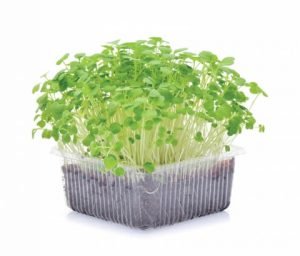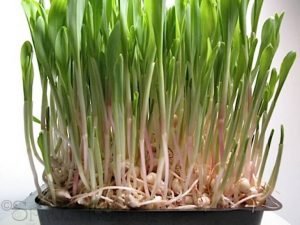Are you ready to adopt a different approach to gardening and growing food? Perhaps you’ve heard of microgreens and how nutritious they are, as well as fast growing.
It is a great way to grow nutritious and healthy food, the fact that you can grow it in your own home and produce as many different types as you wish. Unfortunately, it can also get confusing as people interchange terms.
The simple truth is that microgreens, sprouts, and shoots are all small versions of your chosen plant. They are all nutritious, although they appear to be at their most nutritious during the microgreen stage.
Discovering the difference is essential; it will alter the way you grow your produce and the time you harvest it. Check out the following to discover the real differences between these plants.
What are microgreens?
Microgreens come from the same seed as a mature plant. They are often soaked to speed up the germination process, but this is not always the case.

The seeds, once germinated, are then planted in soil or a growing medium of your choice; coconut coir and earthworm castings are a popular and effective choice.
You then monitor the plants and care for them on a daily basis. They will produce their first leaves after a few days. It will take between 1 and 3 weeks for these leaves to grow, become green, and open flat. As soon as this happens there are ready for harvesting and eating.
The trick at harvest time is to keep the microgreens as dry as possible, you’ll then be able to store them in a plastic bag or container for up to a week.
You can also leave these microgreens for another week until the second batch of leaves emerges; this is usually referred to as ‘true leaves’.
It is worth noting that microgreens need to have a growing medium and some light to ensure they grow properly; although they don’t generally like direct sunlight.
Technically true leaves are different to microgreens but you’ll find that some people refer to everything between microgreens and baby greens,(small versions of the full-grown fruit); as microgreens.
What are sprouts?
Sprouts are also grown from seeds. However, they do not usually need a growing medium. You can usually have sprouts ready to eat within a week, sometimes they take as little as 3 days!

Sprouts are kept in water for the first 2-3 days; to speed up the germination process. After this time they are kept on a tray, in a jar, or in a special sprouter. This allows the seeds to be covered in water two, or even three times a day.
The water drains away but the seeds have all the nutrition they need.
Light is not important at this stage of the plant’s growth.
It is important to rinse them regularly by soaking and draining them; this prevents bacteria build up which can be harmful to the seeds and to you when you eat them. Rinsing introduces clean water to prevent this issue.
Once the seed has sprouted they are ready to eat! You eat the seed as well as the small sprout emerging from it.
What are shoots?
You won’t be surprised to learn that shoots are the in-between stage. They take between 1 and 2 weeks to grow but they should still be harvested before the leaves are fully grown; which would make them microgreens.

Seeds for shoots do generally need to be germinated in water and then transferred to a growing medium, just like microgreens.
They also need some light and regular watering to ensure they grow. Again, these don’t like full sunshine. The shoots will be much thicker than sprouts as they have more time to grow and more nutrition; thanks to the complex root system they can form in the growing media.
Difference between microgreens and sprouts
The main difference between a sprout and microgreens is the growing method. Microgreens need soil or a similar growing medium, sprouts don’t; they do all their growing in water and the air.
In short, sprouts germinate in water and then you rinse them 2 or 3 times a day until the plant starts to emerge.
You’ll then eat the seed and the small sprout.
Microgreens can be germinated in water but they must be transferred to the growing medium. You then nurture them by keeping the soil moist for 2-3 weeks; until the first leaves are fully developed. You then eat the leaf and the stem; but not the seed.
- Difference between sprouting and regular seeds
The seeds used for sprouts and microgreens are the same. The difference is simply in how they are grown and when they are considered ready to eat.
- Which are more nutritious, sprouts or microgreens?
It is generally agreed that microgreens are the most nutritious stage of any plant. They can be 4-5 times more nutritious than the mature plant and 2-3 times more nutritious than a sprout.
This is simply because this stage of a plant’s life is when they need the most nutrient to grow.
Difference between microgreens and shoots
There is actually very little difference between microgreens and shoots. Shoots are harvested before the leaves appear which means they are quicker to grow. They still need the same growing medium and care as microgreens and you still eat the shoot, not the seed.
In fact, these terms can almost be used interchangeably as they overlap each other. You can easily have the first leaves appearing on your shoots when you harvest them. But, you’ll still call them shoots until the first leaves are established; this means full grown.
You even harvest shoots and microgreens in the same way.
Now you know the difference between microgreens, spouts, and shoots you can decide which one you wish to grow and get started!
Are long rooted sprouts with leaf good to consume? I mean mung sprout kept in a strainer with water in another utensil through which roots can absorb water and after 4days it’s has time yellowish leaf on it. Can it be consumed?
Yes you can. They are just bean sprouts.
I am interested in growing microgreens therefore I want to know more about it
I’ve been sprouting broccoli and growing a few microgreens. But I’m wanting a little more variety with the most nutritious for each type. What 3 would you rec for sprouting and what 3 would you rec for growing microgreens?
Thanks!
Radish, mustard, and alfalfa sprouts are great to try out.
Alfalfa, beet, buckwheat, kale are very nice microgreens in my opinion.